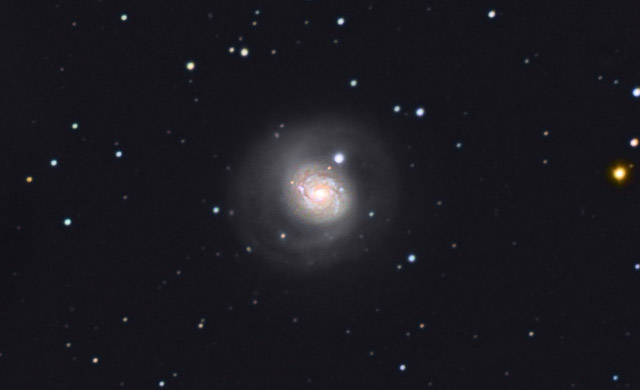M77 is one of the nearest and brightest of the so-called Seyfert galaxies. You've probably never heard of a Seyfert galaxy, but perhaps you've heard of a quasar. A quasar is small enough to fit insider the solar system but hundreds of times brighter than an entire galaxy. How could something so bright be so small? Astronomers now believe a supermassive black hole lives at the center of every quasar. As clouds of gas and dust spiral into the bottomless pit of the black hole, huge amounts of energy are released. Twin beams of ionized particles shoot out the top and bottom of this maelstrom, and if a beam happens to point straight at Earth, we see it as a light that outshines everything else in the area—like a flashlight pointed at your eyes.
But what if the beam doesn't point straight at Earth? Then we see only the turbulent and fast-moving whirlpool of gas as it spirals into the maw of the black hole. We can't see the motion of the gas directly because it's too far away, but we can detect it with a spectroscope. From the side, the whirling cyclone of superheated plasma, has a characteristic pattern when viewed with a spectroscope. It was that pattern that an astronomer in the 1940s observed in a few galaxies. The pattern was very curious, and before the discovery of quasars and black holes, no one knew what the pattern meant. The astronomer's name was Carl Seyfert and the galaxies he noted are now called Seyfert galaxies.
So when you look at M77, do not be deceived by its mild-mannered appearance. Inside its luminous core, shrouded in spiraling gas, lives a monstrous black hole. Deep in its heart, M77 is a quasar.
Imaging Notes
M77 has a huge dynamic range—even greater than most galaxies. The core of M77 is very bright (due to its Seyfert nature); at the same time, M77 has unusually faint and delicate outer arms. The challenge is to bring out the arms without overexposing the core.
Make sure that your processing preserves and enhances the fine an intricate detail in the bright disk. The center is bright enough to take a good amount of sharpening, but make sure that you keep the outer arms smooth. With sufficient exposure time you will see some structure to the outer arms—they are more than just an oval blur. In particular, there are two delicate wisps that start at the edge of the bright core and whip out to the outer edge.
M77's color is difficult to pin down. I've seen a lot of excellent processing that shows the central disk as bright bluish-white. That helps emphasize the bright nature of the core and disk. I've chosen more color contrast in my processing. The bright parts of the disk are blue while the darker gas clouds are orange and brown.
For an advanced challenge, see how much you can increase the image scale and resolution while still preserving the faint outer edges. How much detail can you get in the core? There is a wealth of fine structure in the bright part of the disk.
NGC 1055
The nice edge-on spiral NGC 1055 is only half a degree away from M77. This 7 arcminute galaxy is interesting in its own right, but it also makes a nice companion to M77 if you can capture both in the same frame.

